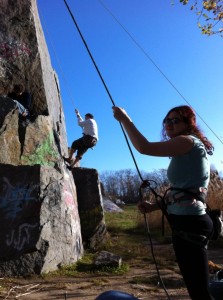Do You Trust Yourself? Should You?
 It’s a compelling headline: Stop Trusting Yourself. By Northeastern University psychologist David DeSteno, it’s featured in today’s NYTimes, and ostensibly shows that we mistakenly trust ourselves – that if anything, we mis-estimate our own trustworthiness more than that of others.
It’s a compelling headline: Stop Trusting Yourself. By Northeastern University psychologist David DeSteno, it’s featured in today’s NYTimes, and ostensibly shows that we mistakenly trust ourselves – that if anything, we mis-estimate our own trustworthiness more than that of others.
Compelling indeed; but like sugar water, the headline high is brief. The problem is not bad psychology – it’s bad meta-psychology. The studies he cites merely describe a part of the puzzle of self-trust, and not necessarily the biggest part at at that.
This is not the first time that “hard” scientists have gushed over “findings” that amount to little more than semantic confusion. The worst offenders are the neuroscientists, who constantly mistake chemical descriptions for higher forms of “explanation.” But this one doesn’t require much knowledge of science.
Trusting Yourself
First, props to Mr. DeSteno for correctly noting something many trust students miss – that trust is an asynchronous relationship between two parties. Trusting “yourself” makes no sense unless we can posit two identities within the self, one of which can be said to trust the other. (This is similar to the issue of consciousness in philosophy). DeSteno quite rightly recognizes the need to define those two selves.
The problem is, he picks one definition and one alone – the “present you” and the “future you.” The rest of his article cites studies about how the “present you” constantly mis-estimates the future you. He cites two “cognitive glitches” to describe this, both of which deal with present and future states.
Well and good. This all makes perfect sense – except that time is only one way to posit the “two-you’s” necessary to make sense of self-trust. Here are three more. I suspect a bit more thought by the reader would yield more still.
1. Trust Your Skills. As in How to Trust Yourself Over Every Golf Shot, where the author offers the definition, “Trust is the ability to suspend one’s judgment about one’s performance (swing).”
Here the two selves are the cognitive, self-observing self, and the instinctual, acting self. Anyone who plays golf, or any sport (or engages in sex as a male) knows the debilitating effects in the here and now of over-thinking things. The same is true for leadership, acting, storytelling, public speaking, and any number of other human endeavors.
Proof that this is an even more common meaning of “self-trust” than DeSteno’s now-future me? Consider the ubiquity and instantly understood Nike slogan, “Just Do It.”
Note that, in these important realms of life, “trust yourself” has nothing to do with time.
Note also that the advice from this definition of self-trust is to “trust yourself” – exactly the opposite of the “don’t trust yourself” advice that DeSteno posits from his time-based example of self-trust.
2. Trust Your Identity. Clinical psychologist, therapist and author David Schnarch incisively describes the self-trust that comes with what he calls differentiation:
Differentiation is basically the ability to balance humankind’s two most fundamental drives. One is our urge to be connected with other people, and the other is the urge to be free and autonomous and direct the course of our life. So both wanting to be in a relationship and wanting to be our own person are the two most fundamental drives and the two fundamental problems that couples have in emotionally committed relationships.
[we have developed] a theorem that helps clients and therapists stay on track, and earns credibility with people who trust no one: Only the best in us talks about the worst in us, because the worst in us lies about its own existence.
The inability to trust oneself leads us to fear others; the inability to trust others leads us to over-rely on our selves. Here the two selves are my self-reliant self, and my other-engaging self.
Proof that this too is an even more common meaning of “self-trust” than DeSteno’s now-future me? Try Googling “I trust myself to” and you’ll get first page hits like this:
When I trust myself to love & take care of myself, it’s easier to trust others because they can’t harm my inner well-being.
And once again – the best advice from this meaning of self-trust is not to distrust yourself, but the opposite – to trust yourself.
3. Mastery over life. In Trusting Yourself, Barbara O’Brien talks about the Buddhist perspective on trusting oneself to stop worrying. The key to trusting oneself is to let go of the chokehold of expectation.
The vibration of trusting/having confidence in your ability to create enjoyable experiences for yourself and what is in line with your highest good. A very good frequency for anyone who is stuck in victim mentality.
Again, this is on the first page of results from Googling “Trust Yourself.”
From the Twelve Step literature comes a similar concept, reflected in the witticism, “An expectation is a pre-meditated resentment.” Detachment from outcome is the key to living in the present, which in turn is the key to living over time.
If you think Buddhism is too esoteric, then let’s go to Harvard Business School. Also on the first page of search on “trust yourself” is an article from the business mainstream HBR Blog Network, How to Teach Yourself to Trust Yourself. In it, author Peter Bregman suggests:
There is a simple remedy to the insecurity of being ourselves: stop asking. Instead, take the time, and the quiet, to decide what you think. That is how we find the part of ourselves we gave up. That is how we become powerful, clever, creative, and insightful. That is how we gain our sight.
Again: a very common piece of human reality. Also, not dependent on time. And, yet another piece that admonishes us to trust ourselves, not to not-trust ourselves.
Science and Philosophy
To make a gross over-generalization – we have come, in recent years, to err on the side of methodology, data, behavioralism, and metrics. That has come at the cost of clear problem definition and common sense. This is most noticeable in the softer social sciences, but it shows up even in economics. And it most certainly shows up in social sciences with the trappings of “hard” science – like studies in behavioral psychology.
No branch of science – not even physics – is immune from the need to properly define questions. Newtonian physics wasn’t wrong; it was just answering one particular set of questions, not all questions.
If you want to examine a social phenomenon – like, say, self-trust – the right place to begin is not with empirical studies, but with doing exhaustive search engine work (the modern version of anthropological field research). How do real human beings, operating in the real world, think about an issue?
In logic, a false premise renders all conclusions logically true. In science, a bad problem definition can support any conclusion whatsoever. In our haste to use all the tools of modern analysis, we have allowed sloppy problem definition. (I won’t go so far as to say we need more philosophers in science. Oops I just did.)
Professor DeSteno is almost certainly not wrong. But that’s not the key question. The key question is – what problem was he solving?
He says he’s solving the problem of self-trust. I say he’s solving the problem of one aspect of self-trust – an aspect that is not likely to be more ubiquitous or relevant than other aspects, and which notably has a different answer than the other aspects.
Caveat reader.

 Credibility is one piece of the bedrock of trust. If people doubt what you say, all else is called into doubt, including competence and good intentions. If others don’t believe what you tell them, they won’t take your advice, they won’t buy from you, they won’t speak well of you, they won’t refer you on to others, and they will generally make it harder for you to deal with them.
Credibility is one piece of the bedrock of trust. If people doubt what you say, all else is called into doubt, including competence and good intentions. If others don’t believe what you tell them, they won’t take your advice, they won’t buy from you, they won’t speak well of you, they won’t refer you on to others, and they will generally make it harder for you to deal with them.
